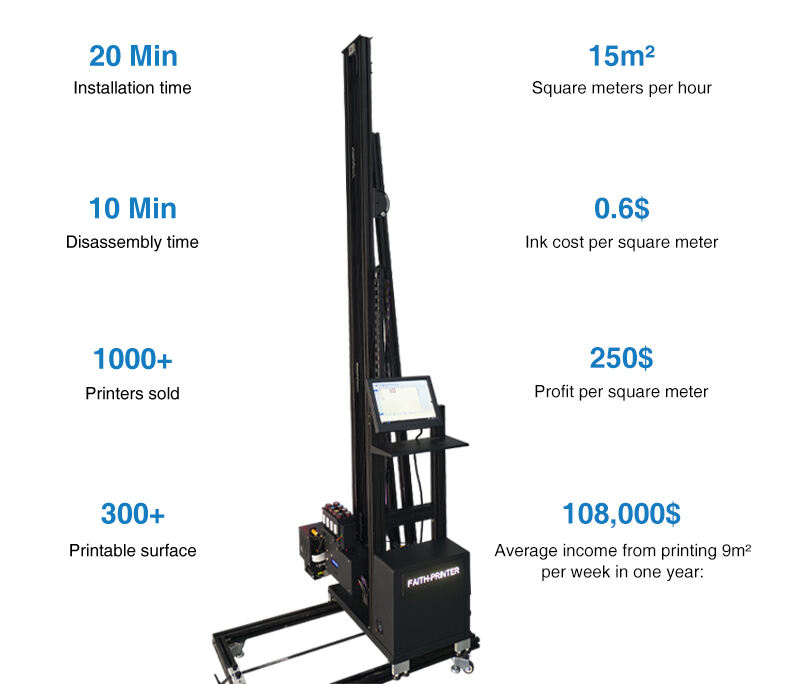Wall printers, as an innovative digital printing technology, are rapidly changing the traditional printing and decoration industry. Its unique features and diverse applications make it show significant potential in commercial value. The following is an in-depth analysis of the commercial value of wall printers, focusing on market demand, technical advantages, financial benefits and industry impact.
1. Market demand and personalized customization
1.1 Changes in consumer behavior
Modern consumers have an increasing demand for personalization and uniqueness. From home decoration to commercial space, customers want to be able to express their personality and brand image. According to market research, the demand growth rate for personalized products is as high as 20%. Wall printers can meet this demand and provide customers with customized wall designs through fast and efficient printing services.
1.2 Extensive industry applications
Wall printers are not only limited to home use, but are also widely used in commercial advertising, public art, exhibitions and other fields. According to industry reports, the market size of the advertising industry is expected to grow to US$50 billion in the next five years, and wall printers have great application potential in this field.
2. Technical advantages and production efficiency
2.1 Printing accuracy and speed
The wall printer uses advanced digital inkjet technology, which can achieve high-resolution printing (up to 1200 DPI), ensuring the clarity of the image and the vividness of the color. Compared with traditional hand-painted or sticker methods, the printing speed of the wall printer can be increased by 70%, significantly shortening the project delivery time.
2.2 Low cost and high efficiency
The use of wall printers can reduce labor costs and material waste. Studies have shown that the cost of projects using wall printers is more than 30% lower than traditional methods. This cost-effectiveness enables companies to maintain price advantages in the fierce market competition.
3. Financial benefits and return on investment
3.1 Profit model
The return on investment (ROI) of wall printers can be calculated by the following formula:
RIO= (net income/investment cost)*100%
By providing customized services and value-added services, companies can achieve sustainable revenue growth. It is expected that under normal operating conditions, the payback period of wall printers is usually between 6-12 months.
3.2 Long-term benefits and market expansion
As the market demand for wall printing services increases, companies can improve profitability by expanding their service scope (such as providing design consultation, installation services, etc.). Industry analysis predicts that the wall printing market will grow at an average annual growth rate of 15% in the next five years.
4. Brand communication and customer experience
4.1 Brand value enhancement
Wall printers provide a new platform for brand communication. By displaying brand stories, core values and product information on the wall, companies can significantly improve brand visibility. Studies show that the brand communication effect of visual content is 65% higher than that of traditional text.
4.2 Customer experience optimization
Unique wall design can not only attract customers' attention, but also improve their overall experience. According to the survey, a good visual experience can improve customer satisfaction and increase customer repurchase rate.
5. Environmental protection and sustainable development
5.1 Use environmentally friendly materials
Wall printing technology usually uses environmentally friendly inks and materials, which meets the expectations of modern consumers for sustainable development. By adopting environmentally friendly technology, companies can not only meet regulatory requirements, but also enhance their brand image.
5.2 Social Responsibility
While promoting sustainable development, companies can also enhance their sense of social responsibility and improve their brand reputation by participating in community art projects and beautifying public spaces.

 EN
EN
 AR
AR
 HR
HR
 NL
NL
 FR
FR
 DE
DE
 IT
IT
 JA
JA
 KO
KO
 PL
PL
 PT
PT
 RO
RO
 RU
RU
 ES
ES
 SV
SV
 ID
ID
 TH
TH
 TR
TR
